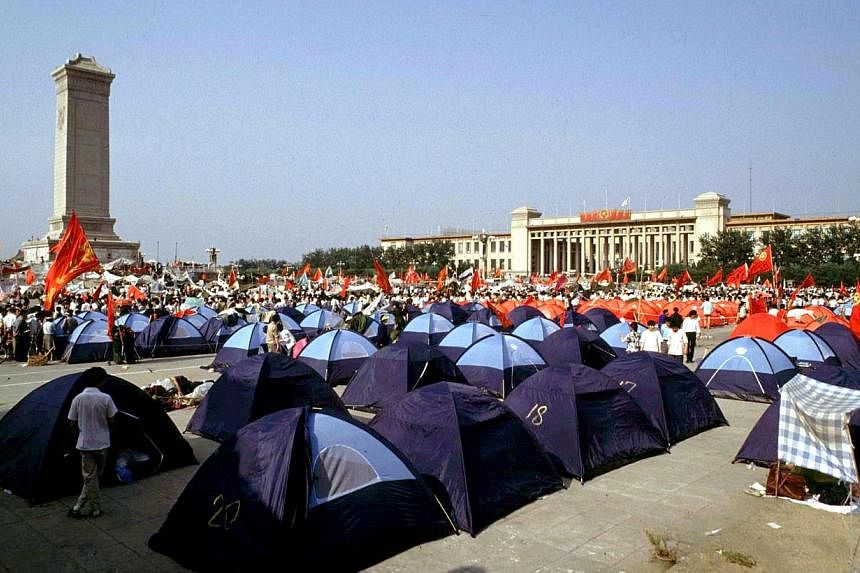In the middle of May 1989, I was in the Kuala Lumpur office of Reuters - where I was bureau chief - when the call came from the editors in Hong Kong.
Drop everything and rush to Beijing, now, I was told. A seemingly innocuous student sit-in hunger strike had developed into a major world story.
Reuters had assembled more than a dozen of its Chinese-speaking reporters from around the world, and when I checked into the bureau located in Sanlitun, in Beijing's diplomatic enclave, many familiar faces were already busy working the phones or hacking away at the keyboards.
I went immediately to Tiananmen Square, the sprawling 40-hectare city square which I had visited many times when I was based in the Beijing bureau for three months in the winter of 1986/87.
This was the venue of major Chinese events such as the May 4 protests of 1919 and Mao Zedong made his famous proclamation of the People's Republic of China in 1949. I remember cycling around the perimeter on weekends, checking out the dumpling and noodle shops in the freezing cold.
But this time the scene was so different, almost surreal. The square resembled a cross-between a refugee camp - with makeshift tents, beach umbrellas, roadblocks manned by students - and a rubbish dump.
The students had gathered there since May 13 - a week before I arrived - and already a stench was building up. I would spend the next two weeks, mostly on the square talking to students, before I returned to Kuala Lumpur at the end of May.
Spirits were high even though afternoon temperatures were starting to climb. The students had commandeered the area immediately around the Monument to the People's Heroes, the granite and marble obelisk to the south of the square dedicated to veterans of Chinese wars from 1842 to 1949.
From here, the leaders gave instructions for food and drinks to be disbursed to volunteers, and for rosters for the makeshift medical tents, road blocks and human barricades which had made it difficult for security forces to enter the square and break up the protests.
For a sit-in of this scale, the students were remarkably well organised. They had passed the hat around and bought their own microphones and speakers, printed pamphlets and wrote up banners for marches. They prepared their own security passes and I too had to pass checks before I could return each time to the command centre.
In the weeks I spent with the students under the tents, I asked one question repeatedly - what are you really protesting about?
The answers ranged from having more press freedom, the removal of martial law (which was declared on May 20) and the removal of Li Peng, the Premier at that time. Mr Li was perceived by the students to be a hardliner opposed to Mr Zhao Ziyang, who was General Secretary of the Communist Party of China when the protests took place.
The students sensed a power struggle within the Chinese elite and felt that Mr Zhao - whom they regarded as reformist sympathetic to their aspirations - was losing out. Shortly after the protests, Mr Zhao was purged by Deng Xiaoping, the paramount leader, and placed under house arrest.
By around May 27, eight days before the tanks rolled in, in one of my last stories filed, student enthusiasm was waning. The crowds had dwindled to around 10,000 - far below the 50,000 in the early days - as the heat, fatigue and stench of uncollected rubbish started to wear patience thin.
Through the years after I have been asked why the Chinese authorities decided to use force on the students. Looking through the lens of history and personal experience, I can only surmise that the top leaders within Zhongnanhai were locked in an intense internal struggle on the issue in which the hardliners eventually won. The incident was a major national embarrassment, under the full glare of the international media, so soon after the visit of Soviet leader Mikhail Gorbachev to Beijing. It had to be stopped, even by force, to avoid further loss of face. Otherwise its own citizens - and the world at large - would always wonder if China's leaders really had the mandate of heaven to rule.
Three months after the incident, I wrote a feature on how the overseas Chinese - including Singaporeans - regarded the Tiananmen incident. After the initial shock and sadness, there was no strong collective consciousness among the diaspora across South-east Asia. Twenty-five years later, hardly any of my friends or business associates who travel frequently to China bring up the subject. Life goes on.
The writer, a former Reuters journalist and the agency's bureau chief in Kuala Lumpur, currently runs an investor relations firm in Singapore.

